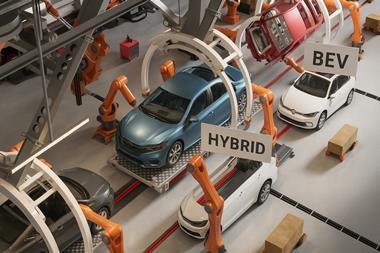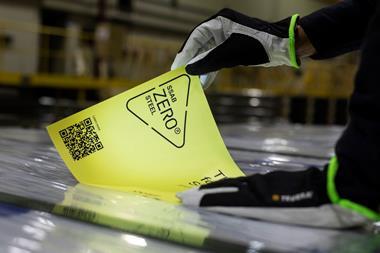The largest automotive manufacturing complex in the world boasts five high-tech plants, but sales slumps and strikes have affected output at Hyundai Ulsan. AMS paid a visit to Fifth Plant to see Genesis production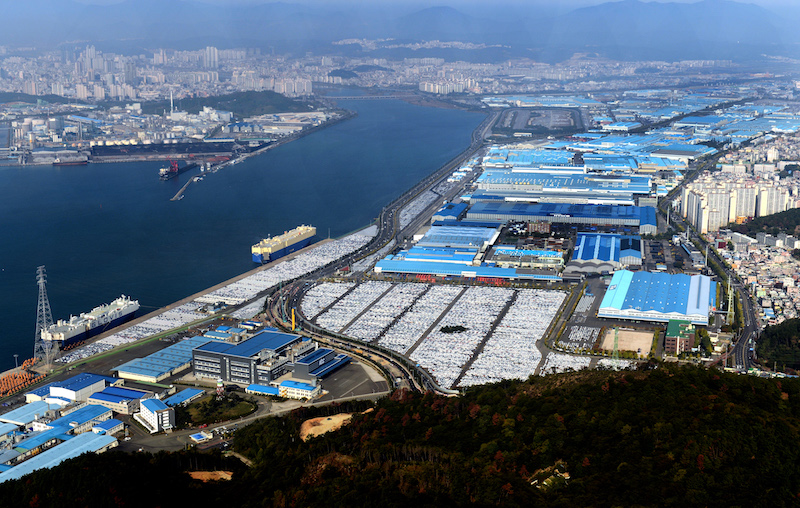 There is no place in the automotive world like Hyundai Ulsan. With five vehicle plants spread over 5m sq.m, the OEM’s manufacturing complex on the south-eastern coast of South Korea is the largest in the industry, capable of turning out more than 1.4m units per year – a staggering 6,000 per day, or one every ten seconds. Although Hyundai has expanded overseas in recent years and now operates 20 plants in eight countries, the Ulsan site is still responsible for about one-third of the OEM’s global production. Around 4,000 vehicles per day are shipped out through the port which lies conveniently close to the manufacturing facilities, totalling 920,000 units last year.
There is no place in the automotive world like Hyundai Ulsan. With five vehicle plants spread over 5m sq.m, the OEM’s manufacturing complex on the south-eastern coast of South Korea is the largest in the industry, capable of turning out more than 1.4m units per year – a staggering 6,000 per day, or one every ten seconds. Although Hyundai has expanded overseas in recent years and now operates 20 plants in eight countries, the Ulsan site is still responsible for about one-third of the OEM’s global production. Around 4,000 vehicles per day are shipped out through the port which lies conveniently close to the manufacturing facilities, totalling 920,000 units last year.
However, capacity is one thing; being able to use it is another. While Ulsan made 1,513,000 vehicles in 2013, more recently production has been hit by difficulties at home and threatened by other issues abroad. In June, domestic sales decreased by 11.6% year-on-year to 61,837 after the end of tax incentives for car buyers, although such a nationwide change is not likely to affect Hyundai’s longstanding dominance in its home market, which sees it taking almost half of all sales alone and over 70% with partner Kia, leaving rivals trailing.
A more serious domestic problem, shared among Korean vehicle-makers, is the frequency of strikes at manufacturing facilities. These happen on an almost annual basis, encouraged by strong unions and wider labour challenges in the country. Since Hyundai employs a veritable army of workers at Ulsan – no fewer than 34,000 – there is potential for a lot of damage to be done. Indeed, particularly troublesome stoppages last year cost the OEM over 100,000 units of lost production and did nothing to help it reverse a slide in profits, which amounted to 5,720 billion won ($4.9 billion) in 2016 compared with 6,509 billion in 2015. Further worker protests took place this summer.
Combine these domestic difficulties with troubles abroad, including a drop in demand in China and threats by President Donald Trump to end free trade between the US and South Korea, and a global capacity of 4,850,000 units a year starts to look unnecessary at best.
Plant One: Accent, Accent Wit, VelostarPlant Two: Santa Fe, Tucson, i40Plant Three: Elantra, i30, IoniqPlant Four: Maxcruz, H-1, H100Plant Five: G80, G80 Sport, G90, G70 (from 2017); Tucson
Total number of models: 13Total capacity: 1,414,000 units
Hyundai also has a plant at Asan to build cars for exports (the Sonata and Grandeur/Azera) and another facility at Jeonju for global commercial vehicles.

A fresh start for Genesis vehiclesThe newest facility in Ulsan’s quintet, opened in 2007, mostly builds the Genesis vehicles with which the Hyundai Group aims to take a share of the luxury market not only at home but in the US, China and the Middle East. Genesis was subsumed within Hyundai for many years but spun off as a separate brand in 2015 and its range now includes the G90, G80 and G80 Sport, while the latest model, the G70, was in pilot production when AMS visited in early June. The plant has an annual capacity of 130,000 vehicles and in addition to Genesis models it makes the Hyundai Tucson SUV, including a fuel-cell version in a separate facility. Last year, 87,172 Genesis vehicles were shipped worldwide from Fifth Plant.
In general, the five Ulsan plants are equipped with similar technology, for example machines that are designed to handle multiple different models. However, Fifth Plant pioneered roof laser brazing in late 2015 for the G90 to improve exterior quality, as well as ultimately boosting cost-effectiveness by simplifying the roof mounting process. Laser brazing is not applied to the G80 model, which passes through the station untouched, but it will be performed on the G70 in series production; at the time of AMS’ visit, only pilot cars had been treated in this way. The process is conducted in 30 seconds and within a tolerance of 0.3mm; the roofs are then examined for flaws, but these are found in fewer than 3%, ie only a handful of units. Three checks take place per vehicle, two robotic and one by personnel; double or triple checking to ensure quality is something that Fifth Plant director Hyunwoo Cho (see interview below) regards as a feature of Genesis production.
Elsewhere, an electrical measuring system not commonly seen in bodyshops is used to ensure high-quality closures. A worker hooks a hinge onto one of three ‘pillars’ standing next to the line, then the entire system slides towards the vehicle body so that the employee can tighten the bolts. ‘Perfection before production’ reads a banner in the bodyshop, and indeed this system is one of several used in Genesis manufacture which embody this philosophy.
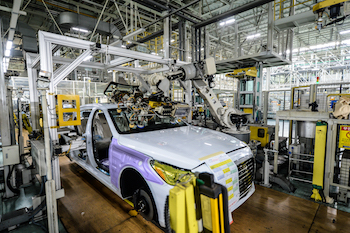 A Genesis vehicle spends nine hours in the assembly hall
A Genesis vehicle spends nine hours in the assembly hallThe luxury of lower cycle timesThe bodyshop is almost 100% automated, with 157 Yaskawa robots and only 100 people and, like most other facilities at Ulsan, it operates two shifts per day. However, throughput is slower at only 24-28 cars per hour, partly due to the premium nature of the vehicles produced. It takes eight hours to weld a Genesis body, compared with two hours for the Elantra in Third Plant; this is followed by 11 hours in the paintshop and nine hours in assembly (versus seven and five hours respectively).
By contrast, the assembly hall is only around 10% automated and requires 500 workers per shift, 1,000 per day. On the Genesis line (the other builds the Tucson) the cycle time is about 130 seconds due to the high number of parts and the care taken to install them, making it only half as fast as the quickest facility at Ulsan, Third Plant. Consequently, the 1.3km conveyor moves slowly and it takes more than a full shift to bring a Genesis vehicle from start to finish.
Engines, transmissions and seats for Genesis cars are all made at Ulsan, though other components come from affiliates and suppliers within South Korea; racks and trolleys are used for lineside kitting to make installation more efficient. One notable aspect of the assembly procedure is the fitment of the front and rear axles as a single unit to save time. This module sits on its own platform ready for integration by four personnel into the car body, now raised overhead. A little further down the line are three more platforms on tracks, their movement controlled by the workers, who are busy installing parts, adjusting torque and fitting fuel sensors and the tyre pressure monitoring system. When the vehicle is complete, it heads off to be inspected and tested – more than once, of course.
In need of regenerationThe Hyundai Group’s bestseller within its latest brand is the G80, of which 3,425 were sold in South Korea in June while 2,607 were exported, bringing the H1 total to 20,973 domestically and 11,453 abroad, with exports picking up pace over the first six months of the year. However, the OEM clearly cannot rely on premium models to bolster overall numbers. Alongside the drop in Hyundai’s domestic sales of 11.6% in June, overseas sales were down 16.2% compared with the previous year, at 314,272, which the company said was due to reduced demand in China. In April, Reuters claimed that both Hyundai and Kia had cut production at their Chinese factories after sales slumped amid a political dispute. Since July, capacity has surely slipped further out of line with demand after the opening of Hyundai’s fifth plant in China, which has added 300,000 units to a total of 1.65m in the country.
Meanwhile, if Donald Trump carries out his threat to end free trade between the US and South Korea, among many international agreements in his sights (but not yet terminated, it should be noted), then Hyundai would be one of the biggest losers. Although the OEM has had a plant in Alabama since 2005, the US is still one of its largest export markets, taking 38,400 Hyundai vehicles in June and 187,281 in the first six months of the year (including 1,281 G80s for the month and 7,767 up to June). “Amid slowing global economic growth, uncertainties are rising more than ever as protectionism spreads and competition intensifies in the auto industry,” chairman Mong-Koo Chung told employees in January.
Chung’s remark came after the second consecutive year in which Hyundai and Kia missed their global sales goal, selling 7.88m against a target of 8.13m worldwide (4.86m against 5.01m for Hyundai). It was the first annual sales fall since 1998 and also the fourth year of decline in profitability. With sales and production difficulties at home and political complications abroad, now is clearly not the most positive period for the Group, though it is far from the only OEM struggling to maintain growth in turbulent times. But the owner of the largest automotive manufacturing complex in the world has not stopped dreaming big; it has set a sales target of 8.25m this year – higher even than in 2016.
Ulsan is unusual in having five plants at one location. Are there any manufacturing benefits – collaboration or healthy competition?For example, Fifth Plant doesn’t have a press line, so we get the pressings from the First or Third plants. We get engines from the engine line. So in terms of supply, we can share parts. We can also exchange information for the production of the cars. If we have a faulty part or problems when we make specific models, we can say “we have this problem, maybe you can fix it if you had the same problem”. For example, the Tucson model is in parallel production between Fifth Plant and Third Plant because the market demand is high. We can meet market demand more flexibly because we have five plants.
Is one of these plants a kind of testing ground for new technology?We don’t have a specific manual for which plant applies the newest technology first. But as Fifth Plant produces luxury models like G80 and G90 there is more possibility that it applies the newest technology first; but that’s not the exact case. Overall, the technology in the five plants is similar.
What examples of new technology have been pioneered by fifth plant?Roof laser brazing was implemented in Fifth Plant first, in late 2015. It’s applied to the G90 model and it will be applied to G70, the new model that will come out later this year. In 2007, the painting technique that we applied first using water-soluble paint, which is eco-friendly, led to high-quality exterior colour.
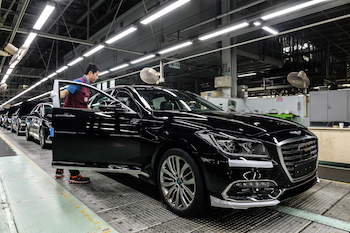 Before joining the line, each worker trains on six vehicle bodies
Before joining the line, each worker trains on six vehicle bodiesHow is the plant preparing for series production of the G70?The pilot production began in April. There’s a tryout stage in the plant for when the new model comes in. In that period, the workers have to educate themselves for the new model skills; they have to check which technique is new and which is different from the previous model.
Is Genesis training different from standard Hyundai training?There are two parts: assembly or manufacturing aspects; but before that they go to the R&D centre and are educated about the new model. So for other models only 50-60 workers go to learn the skills. But for the Genesis line about 80 people go to the R&D centre, then they come back and they educate their colleagues. Each worker has to make the car six times before they get into the manufacturing process; at other plants they test themselves three times.
Since Genesis is a premium brand, what are the production criteria?We double-check the quality, both exterior and driving quality. We test-drive twice; we have implemented a smart driving monitoring system and electrical device and tyre test system before we send the cars outside the plant. This is called PDI – pre-departure inspection – which is the final quality check before we ship the car, and this is double as well. Manfred Fitzgerald, who is in charge of the Genesis brand at headquarters, comes down to Ulsan plant two to three times per month to ensure the quality of the Genesis brand. Also, the overall head of the Ulsan plant, Gap Han Yoon, checks every month.
Fifth Plant has also looked after fuel-cell vehicle production since the ix35 (Tucson) was launched in 2013. How does that compare?Though it is considered part of Fifth Plant, a separate facility was built for fuel-cell vehicles. It’s different from the other lines because the fuel-cell plant is basically cell-orientated production. The workers assemble one part and in the next cell they assemble another. Also, we don’t have the fuelling station inside the plant so we have to go outside to fill the hydrogen gas then come back.
How many fuel-cell vehicles are being made per day?One per day, because market demand is low at this point. But if the demand elevates we can move to two shifts because it is one shift right now, unlike the other plants, and elevate the production volume.
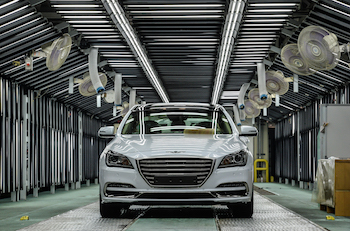 Genesis cars are sold in South Korea and exported to markets such as the US, which took 7,767 G80s this year up to June
Genesis cars are sold in South Korea and exported to markets such as the US, which took 7,767 G80s this year up to JuneOverall, the automation level at Hyundai is very high. Is it a case of more automation is better or is manual work important as well?Automated technology can ensure consistent high quality of the product. Handcraft is really good but it can lead to poor quality. So automation prevents the errors that can come from workers. It’s more efficient for producing cars. Also, it prevents industrial accidents.
Manufacturers of luxury cars often like to emphasise that they are handbuilt but Hyundai seems happy to automate even for premium vehicles, is that correct?Because this ensures high quality. Actually, the workers double-check the quality, so it’s not all automated – it’s a combination. Workers check for errors that can come from the automated systems and robots check with lasers and cameras the errors from the handcrafting. Because it’s a luxury brand, we make sure it has the highest quality. It’s not one or the other.


































